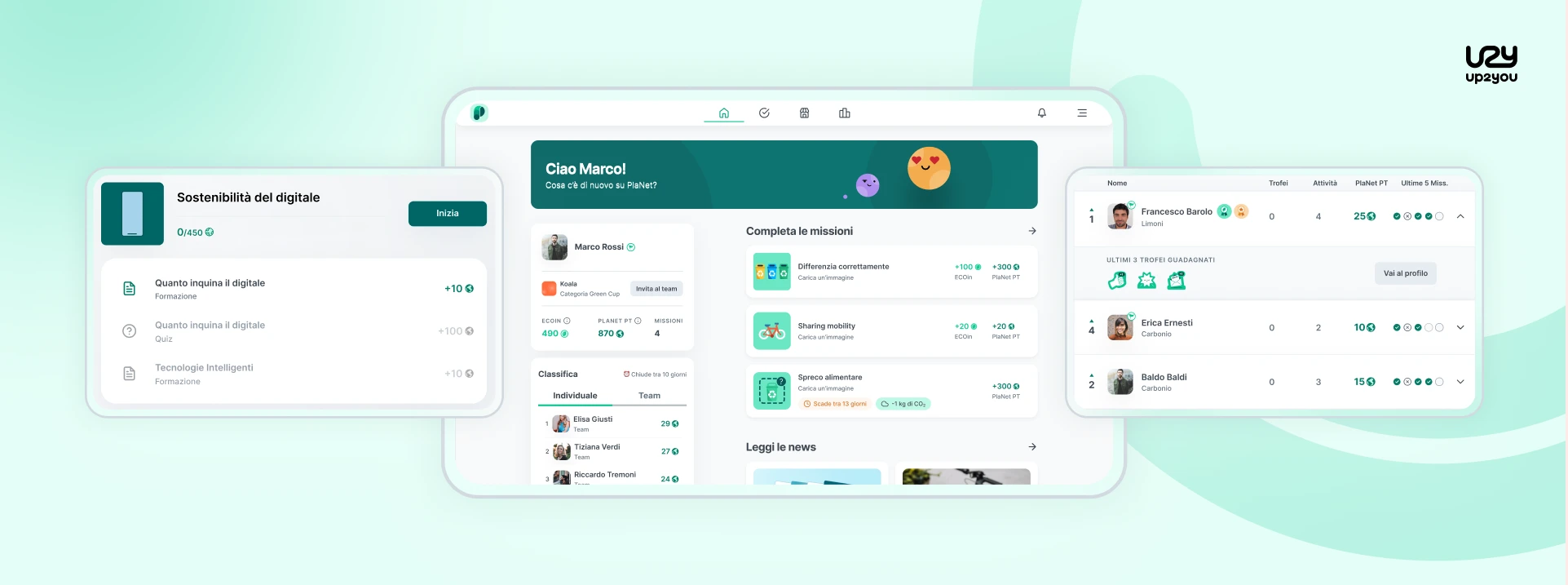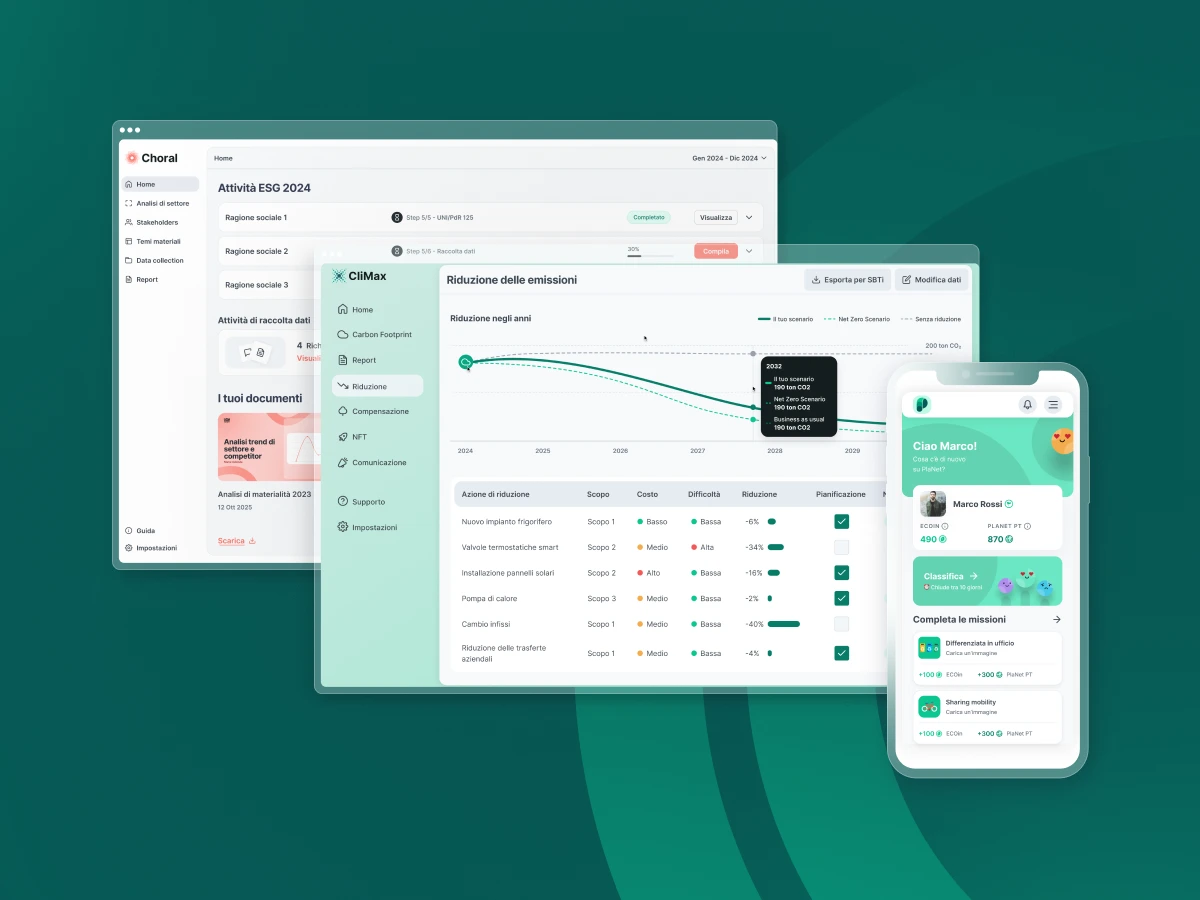{summary#bullet-1}
ESG criteria: the key to increasing the value of a company
In the current landscape, sustainability has become a determining factor for the growth and enhancement of companies, not only for investment funds but also for portfolio companies.
The companies that integrate environmental, social and governance (ESG) criteria in their strategy, they demonstrate greater ability to adapt, less exposure to risks and a stronger reputation in the eyes of investors, customers and stakeholders.
Reporting ESG results is no longer an exercise in transparency for its own sake, but a real tool for value creation. For many investee companies, this activity does not stem from a regulatory obligation, but from a optional strategic choice: the desire to demonstrate with objective data their commitment to sustainability and to strengthen their competitive position.
In fact, having reliable, measurable and comparable information makes it possible to Show in a concrete way how the company manages resources, reduces negative impacts and generates benefits for the economic, social and environmental context in which it operates.
This approach to reporting, often voluntary, makes it possible to anticipate market trends, improve the confidence of investors and stakeholders and, above all, increase the value of the company in view of a future exit or new investment rounds.
The ability to Communicate in a structured way its ESG performance thus becomes a lever for attracting capital, consolidating partnerships and differentiating itself in an increasingly competitive environment.
In a market where sustainability is synonymous with reliability and foresight, undertaking an ESG measurement and reporting process is not only a good practice: it is a strategic choice which helps to build lasting value and solid reputation, key elements for long-term growth and success.
{summary#bullet-2}
Measuring the ESG impact: the first step in generating value in an investment company
The creation of ESG value starts with measurement of the impact generated.
To be able Communicate effectively and crediblyand their commitment to sustainability, companies must first of all be able to quantify the results of your actions in environmental, social and governance terms. Only what is measurable can be valued, and only what is valued can contribute concretely to the growth of the company.
In recent years they have established themselves internationally recognized methodologies and tools that allow companies to assess the impact in a structured and comparable way.
Among these, the most common and which can represent added value for the participating companies are:
- B Impact Assessment, the methodology behind the certification B Corp, which measures the overall performance of a company and its ability to generate value for people, communities and the environment. ;
- SROI (Social Return on Investment), which translates social and environmental impact into economic value, highlighting the return generated for the community;
- Theory of Change, a planning and evaluation model that helps link business activities to the results and long-term effects produced.
A crucial element in this process is the identification of additionality metrics, that is, the ability to measure what the company generates more than a reference scenario. This principle makes it possible to demonstrate theactual added value that sustainable practices produce over time, both for the company and for the community.
Measuring impact does not only mean complying with a good transparency practice, but building a competitive advantage. A structured assessment based on recognized metrics improves the perception of the company among investors, customers and partners, who can thus recognize its solidity, commitment and long-term vision.
{summary#bullet-3}
Certifications, ratings and ESG initiatives for portfolio companies
After starting a measurement and reporting process, the next step for many companies is to obtain a certifying, an ESG rating or a sustainability certification. These are increasingly important tools for consolidating the company's reputation, credibility and transparency, providing an objective and verifiable assessment of its level of maturity in the environmental, social and governance fields.
Unlike simple statements of intent, certifications, ESG ratings, and initiatives are based on concrete data and shared standards, and make it possible to clearly communicate the results obtained and future commitments.
The most internationally recognized certifications and assessment systems include:
- B Corp, which evaluates the entire business impact on people, communities and the environment, measuring the ability to generate shared value;
- EcoVadis, a globally widespread ESG rating platform, used by large companies and investors to assess the sustainability of the supply chain;
- CDP (Carbon Disclosure Project), an environmental reporting system focused on emissions, water resources management and risks related to climate change.
To achieve concrete results, it is essential that the path to a rating or certification or an initiative is supported by a clear strategy. This means:
- define realistic objectives consistent with the business model, avoiding standardized or purely communicative approaches;
- collect and analyze data in a structured way, to ensure the soundness and verifiability of the information presented;
- implement improvement actions aimed at bridging the gaps that emerged during the evaluation phase and at consolidating performance over time.
In a market where sustainability is increasingly a parameter of selection and trust, having a authoritative recognition allows investee companies to stand out and to communicate their strength in a clear, measurable and credible way, positively affecting the economic valuation in view of a future exit or other investment rounds.
{summary#bullet-4}
Sustainability reporting for portfolio companies
Sustainability is not a static goal, but a continuous improvement process which requires structured management, consistent and integrated with the business strategy. For investee companies, this means transforming ESG reporting from a monitoring activity to a planning and growth tool.
An effective path starts fromanalysis of ESG gaps and risks, useful for understanding the organization's level of maturity and identifying the most relevant areas for improvement. This phase allows you to define concrete and measurable objectives, consistent with the business model and aligned with the main international frameworks.
From here we build a customized ESG strategy, which integrates environmental, social and governance aspects into operational decisions and business processes. The fundamental pillars of this path include:
- strengthening ESG governance, with clear internal policies, defined roles and transparent responsibilities;
- obtain environmental certifications like ISO 14064, ISO 14068 or adherence to Science Based Targets initiative (SBTi), to guarantee the credibility of emission reduction commitments;
- Calculate the company's carbon footprint and develop decarbonization strategies in line with European climate objectives;
- Report the results according to internationally recognized standards, such as GRIS (Global Reporting Initiative), ESRS (European Sustainability Reporting Standards) or SASB (Sustainability Accounting Standards Board).
The goal is to build a sustainability management system that is clear, verifiable and oriented to continuous improvement. In this way, reporting does not become a document to be drawn up afterwards, but a dynamic process that accompanies the company in its growth, strengthens its reputation and prepares it for a transparent dialogue with investors, customers and stakeholders.
{summary#bullet-5}
Training and culture of sustainability for portfolio companies
ESG growth depends not only on metrics and strategies, but also on persons that make them possible. For sustainability to become an integral part of the way a company operates, it is essential that ESG principles are understood, shared and translated into concrete behavior by those who guide and manage its activities.
La internal training It therefore plays an essential role: it allows creating awareness, disseminating specific skills and integrating sustainability into daily decision-making processes.
Through targeted programs, workshops and masterclasses, teams can acquire a deeper knowledge of ESG issues, from the management of emissions to ethical governance, from the measurement of social impact to diversity & inclusion practices.
Investing in the culture of sustainability means strengthening the organization's ESG maturity over time. Conscious and trained management is able to make more responsible decisions, anticipate risks and identify opportunities for innovation, while engaged and informed employees become ambassadors of change.
In this sense, training is not an ancillary activity but a strategic accelerator, capable of making sustainability a structural element of corporate identity. Disseminating knowledge and skills within the investee companies makes it possible to consolidate a common vision, improve the consistency of actions and ensure that ESG objectives do not remain on paper, but are translated into concrete and measurable results.

{summary#bullet-6}
Up2You's platforms as a tool to increase the value of portfolio companies
Tackling sustainability effectively requires not only skills and strategies, but also digital tools able to simplify the collection, analysis and communication of ESG data.
Le Up2You platforms, Choral, ClimaX and PlanET, were created precisely to meet these needs, supporting participating companies in building a management and reporting system transparent, automated and aligned with the main international standards.
Thanks to the experience gained with companies belonging to the most diverse sectors, Up2You is able to adapt its digital tools to the specificities of each business context, ensuring a flexible and scalable approach.
This makes its solutions particularly effective even for heterogeneous fund portfolios, where companies with different sizes, business models and levels of ESG maturity coexist.
Choral: the platform for ESG reporting
Choral is Up2You's digital solution designed for digitize the entire ESG reporting process.
It allows you to collect and consolidate data from different sources, to process them according to the reference frameworks (ESRS, GRI, SASB) and to generate consistent and verifiable reports.
Thanks to the possibility of customize indicators and questionnaires, each company can adapt the system to its specificities, ensuring constant monitoring and clear communication to investors and stakeholders.
CliMax: the tool for measuring and managing emissions
Climax is the platform dedicated to measurement of the company's carbon footprint and to the development of strategies of Decarbonization.
Through a certified calculation model that complies with ISO 14064 and ISO 14068 standards, it allows direct and indirect emissions to be monitored in real time, identify the main areas of impact and define reduction plans consistent with the objectives of Science Based Targets initiative (SBTi).
For investee companies, this translates into the possibility of integrating emissions management into their business plan, improving environmental performance and credibility with the market.
PlaNet: the digital solution for training on ESG issues
PlanET is the Up2You training platform dedicated to dissemination of culture on sustainability thanks to gamification processes. It offers courses, interactive modules and personalized courses for teams and companies, designed to integrate ESG principles into daily business decisions. Through a practical and modular approach, PlanET allows you to consolidate over time the ESG maturity of the organization, transforming training into a real engine of change.





























